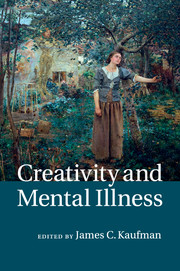Book contents
- Frontmatter
- Dedication
- Contents
- List of figures
- List of tables
- List of contributors
- Preface
- Acknowledgments
- Part I Creativity and mental illness: the state of the field
- Part II Cognitive and neuroscientific perspectives on creativity and mental illness
- Part III Creativity and the spectrum of mental illness
- Part IV Creativity and mental illness: possible commonalities
- Part V Creativity and mental health
- Part VI Creativity and mental illness: what now?
- 18 Ruminating about mental illness and creativity
- 19 Creativity and mental illness: reasons to care and beware
- Index
- References
19 - Creativity and mental illness: reasons to care and beware
from Part VI - Creativity and mental illness: what now?
Published online by Cambridge University Press: 05 August 2014
- Frontmatter
- Dedication
- Contents
- List of figures
- List of tables
- List of contributors
- Preface
- Acknowledgments
- Part I Creativity and mental illness: the state of the field
- Part II Cognitive and neuroscientific perspectives on creativity and mental illness
- Part III Creativity and the spectrum of mental illness
- Part IV Creativity and mental illness: possible commonalities
- Part V Creativity and mental health
- Part VI Creativity and mental illness: what now?
- 18 Ruminating about mental illness and creativity
- 19 Creativity and mental illness: reasons to care and beware
- Index
- References
Summary
As I was finishing up this project, a colleague asked me a question that stuck with me – Why exactly was I doing this book? I ask myself that question every time I am in the final stages of an edited project, as I track down the last chapters and begin the marketing questionnaires. But, of course, this question was a bit deeper. Why creativity and mental illness? Why study it?
Some would argue the topic has been done to death. There have been hundreds and hundreds of studies, most of them analyzing one small piece of the puzzle. Small effects or mixed results are overstated – or consistent patterns are minimized. The benchmark papers are flawed and, even if perfectly executed, would only shed light on one aspect of the question. The analogy of the blind men and the elephant (all touching a different part of the creature and reaching quite distinct assumptions about its essence) is overused but particularly apt in this field.
Part of me is ready for this question with two quotes. One is from my favorite play, Tom Stoppard’s Arcadia. The quote is spoken by an academic; her first sentence refers to her friends’ different research interests in mathematics, history, and English literature:
It’s all trivial – your grouse, my hermit, Bernard’s Byron. Comparing what we’re looking for misses the point. It’s wanting to know that makes us matter . . . If the answers are in the back of the book I can wait, but what a drag. Better to struggle on knowing that failure is final.
(Stoppard, 1993, pp. 75–76)- Type
- Chapter
- Information
- Creativity and Mental Illness , pp. 403 - 407Publisher: Cambridge University PressPrint publication year: 2014



